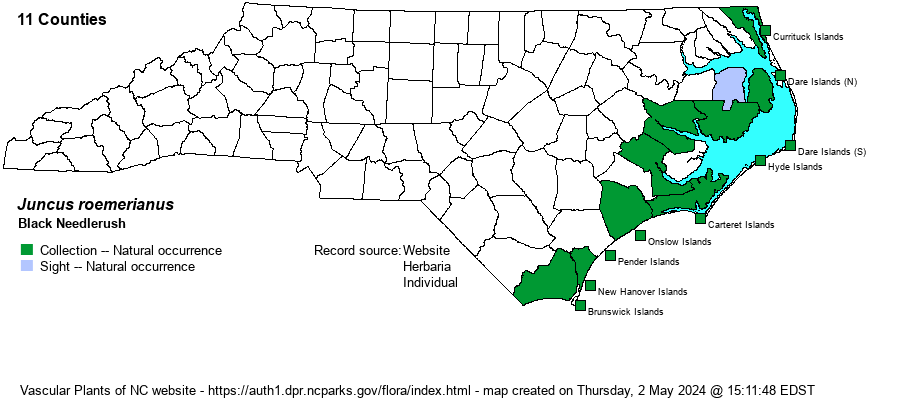| Author | Scheele | |
| Distribution | Outer Coastal Plain, Outer Banks, and barrier islands.
Maritime -- DE to southern FL and southeastern TX; northwestern Bah.; reportedly Hispaniola. | |
| Abundance | Abundant and dominant where found. Forms dense stands covering dozens of acres, almost to the exclusion of other vegetation. | |
| Habitat | Brackish and fresh-tidal marshes, at or just above sea level. Black Needlerush is a critical component of the highly productive (ecologically and economically) coastal marshes, which are essential to the viability of shellfish, crabs, and fishes. |
| Phenology | Flowering and fruiting May-October. | |
| Identification | Black Needlerush is unmistakable and is a dominant or co-dominant member of our maritime marshes -- often essentially forming "brackish marshes" all by itself. Vast acreages border the sounds, especially Pamlico Sound. Plants form dense patches via scaly rhizomes and send up stems 3-4 feet tall. The inflorescence appears lateral, but in fact is terminal with a long, erect, very sharp bract much exceeding it. Be careful walking through a stand of this plant, as you will probably get stabbed a few times by the very sharp stem tip --- a painful experience. | |
| Taxonomic Comments | None
NOTE on Juncus: These "grasslike" or "sedgelike" plants occur in most habitats, especially where moist or wet. They can immediately be told from grasses and sedges by the presence of 6 tepals (petal-like) that surround the fruit. These tepals can be thought of as analogous to sepals and petals of, say, lilies or trilliums. Most species have brown, chestnut, or reddish tepals and dark brown fruits. The flowers occur in few- to many-flowered heads. Leaves are nearly all basal and round in cross-section. Stems are unbranched, except for the inflorescence. Fruits are termed capsules and contain many tiny seeds. | |
| Other Common Name(s) | Needlegrass Rush | |
| State Rank | S5 | |
| Global Rank | G5 | |
| State Status | | |
| US Status | | |
| USACE-agcp | OBL link |
| USACE-emp | OBL link |

